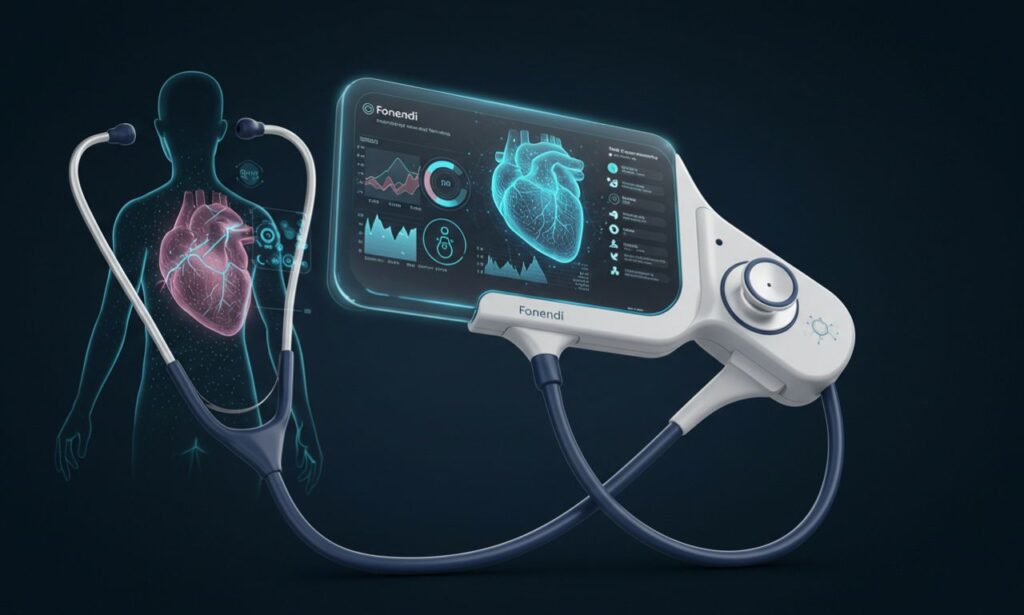The humble stethoscope has long been the symbol of medical practice. For centuries, it has represented trust, listening, and the first step in diagnosis. Yet as healthcare advances, so must the tools doctors use. Enter Fonendi, a next-generation diagnostic stethoscope that merges tradition with artificial intelligence.
Fonendi is not just about listening to heartbeats and breathing. It’s about transforming how clinicians capture, analyze, and interpret body sounds. With features like AI-powered analysis, digital sound enhancement, and remote connectivity, Fonendi is pushing auscultation into a new era.
This article explores how Fonendi works, why it matters in today’s medical landscape, and how it could change the future of healthcare.
The Meaning Behind Fonendi
The word Fonendi traces its roots to “phonendoscope,” an advanced version of the classic stethoscope designed for better sound amplification. In its modern form, Fonendi keeps that heritage alive but redefines it with digital intelligence.
By combining sound, technology, and identity, Fonendi symbolizes a bridge between old-school clinical practice and the new digital-first healthcare ecosystem.
Fonendi’s Advanced Features
AI-Driven Sound Interpretation
Unlike a traditional stethoscope that relies solely on a doctor’s ear, Fonendi uses AI algorithms to analyze sounds in real time. Abnormalities such as heart murmurs, arrhythmias, or lung wheezing can be flagged instantly, giving doctors an added layer of diagnostic confidence.
High-Fidelity Digital Audio
Fonendi enhances auscultation by filtering out background noise and amplifying subtle sounds that are often missed. This ensures physicians hear the clearest possible representation of the body’s internal functions.
Connectivity and Cloud Storage
Fonendi isn’t confined to in-person exams. With wireless streaming and cloud integration, doctors can record, review, and even share auscultation sessions with colleagues or specialists worldwide.
Built-In Smart Tools
The device allows for recording, annotation, and playback, turning routine checkups into rich data-driven interactions. Doctors can track progress over time or compare new recordings with older sessions.
How Fonendi Works in Practice
Using Fonendi feels familiar yet futuristic. The doctor places it on the patient’s chest, back, or abdomen, just like a traditional stethoscope. But instead of relying only on the ear, Fonendi’s sensors capture the sound digitally, process it through AI algorithms, and present both audio and visual waveforms.
This dual approach—listening plus visual confirmation—helps doctors identify issues faster and more accurately. It’s especially helpful in noisy environments like busy clinics or rural settings where distractions can make traditional auscultation challenging.
Applications of Fonendi in Healthcare
Cardiology
Fonendi’s enhanced precision allows cardiologists to catch minor murmurs or arrhythmias that may be missed during routine checkups.
Pulmonology
Lung conditions like asthma or COPD become easier to monitor thanks to detailed lung sound recordings and AI alerts.
Telemedicine
Remote doctors can listen to a patient’s body sounds in real time, enabling care even when physical presence isn’t possible.
Medical Education
Fonendi serves as an excellent teaching tool, letting students both hear and see the sound patterns of different conditions.
Rural and Low-Access Clinics
In places where specialists are scarce, Fone-ndi provides frontline practitioners with better tools to catch problems early.
Why Fonendi Matters Today
Improving Accuracy
Traditional auscultation depends heavily on a doctor’s experience and hearing ability. Fonendi reduces errors by supplementing the ear with objective AI support.
Supporting Telehealth
With telemedicine becoming the new norm, Fonendi’s ability to stream sounds to remote physicians ensures high-quality care beyond hospital walls.
A Teaching Revolution
For medical students, Fone-ndi turns invisible sounds into visual learning materials, improving their training and understanding of clinical signs.
Challenges for Fonendi
Cost Barriers
As a high-tech device, Fone-ndi may be more expensive than traditional stethoscopes, making adoption slower in underfunded regions.
Training Requirements
Doctors must learn how to interpret AI-generated data and integrate digital workflows into daily practice.
Technology Dependence
Fonendi’s reliance on connectivity and power means it may face limitations in areas with poor infrastructure.
Psychology of Using Fonendi
Doctors are trained to trust their instincts and hearing. With Fonendi, they’re asked to trust a machine alongside their judgment. This shift can feel uncomfortable at first, but over time, physicians recognize that technology doesn’t replace their expertise—it amplifies it.
Patients, too, often feel reassured when they can see their health data visualized, making consultations more transparent and engaging.
The Future of Fonendi
AI as a Diagnostic Partner
Future versions of Fonendi may evolve from detecting sounds to predicting disease risks, turning it into a preventive health tool.
VR and AR Integration
Medical schools may integrate Fonendi recordings into VR and AR platforms, creating immersive learning experiences.
Electronic Health Record (EHR) Integration
Soon, Fonendi’s data could sync directly with patient health records, streamlining clinical workflows.
Global Expansion
In developing countries, affordable versions of Fone-ndi could democratize access to advanced diagnostics, saving lives where resources are scarce.
Conclusion
Fonendi is more than a gadget—it’s a healthcare revolution. By merging AI intelligence with traditional auscultation, it empowers doctors with sharper tools, patients with better care, and students with deeper learning opportunities.
While challenges like cost and training remain, the potential of Fonendi far outweighs them. As telemedicine grows and technology becomes more accessible, Fone-ndi may soon become as common as the traditional stethoscope—only smarter, sharper, and more connected.
The stethoscope has always been about listening. With Fone-ndi, we don’t just listen better—we understand more, act faster, and care smarter.







